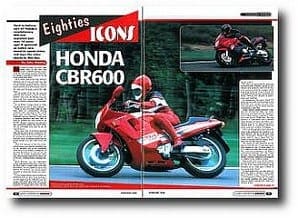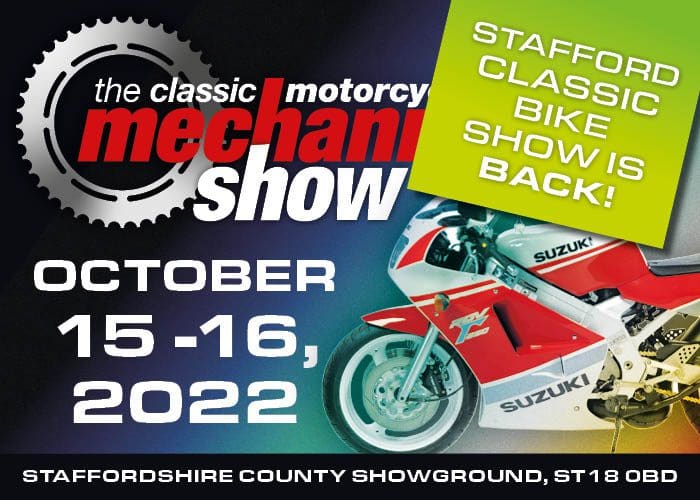
Honda's engineers had to learn the hard way that the combination of performance, flexibility and nimble handling that has become their byword had to be developed both on the road and the track, and at the right price. By the middle of the 80s, the Japanese factories had reached a plateau of development: they were all offering twin-cam fours with four valves per cylinder. To improve further a breakthrough was needed.
At the IFMA Cologne Show in 1986, Honda came up with a radical solution.
While in the 550-600cc class we had been used to conventional looking machines with everything in the normal places like air-filter boxes, the new CBR600F was very different. Drawing on a principal that had first been used on bikes by Yamaha two years earlier on the FZ750, Honda's engineers introduced a new watercooled engine that would establish the principals now used by all the manufacturers.
These were, that to minimise pumping losses and get more power, the inlets to the cylinders needed to be much straighter. So, by canting the cylinders forward the carburettors would be almost vertical and the airbox would be at the front of the fuel tank.
Other key features of the new water-cooled engine were that the camchain was on the left-hand end of the crankshaft rather than in the middle, enabling one of the main bearings to be removed and the inlets to be further straightened rather than being canted towards the centre line of the bike, creating further pumping losses.
More dramatic was the CBR6 00F's styling. Although the bike used a new double-beam type of frame made from steel fabrications, you couldn't see much of it because the machine was almost totally enclosed in an integrated fairing and associated bodywork.
00F's styling. Although the bike used a new double-beam type of frame made from steel fabrications, you couldn't see much of it because the machine was almost totally enclosed in an integrated fairing and associated bodywork.
A year earlier Honda had launched the VFR750F with an alloy frame housing a vee-four engine but the CBR600F (and the similar CBR1000F and CBR750F for the Japanese domestic market) was a complete departure in design from what we had become used to.
The logic was impeccable. By employing aerodynamically designed plastics to provide the style statement, there was no need to be concerned about the cosmetics of the underlying hardware. It was a shock, but it worked because the bike performed brilliantly, offering new horizons of performance and handling.
By comparison, the sports Hawk GT 650cc vee-twin with a chassis based on the VFR75OR racer for the road was much more expensive in the US market and was a comparative sales flop.
Engine internal design provided a new base for development. Bore and stroke were more oversquare than the opposition at 63 x 48mm, giving a capacity of 599cc and a redline of 12,000 rpm.
The four Mikuni CV carburettors had a nominal choke diameter of 32mm and with a compression ratio of 11:1, peak power was a claimed 85PS at 11,000rpm, while the torque peak was 6.0 kgm at 9500rpm. Drive was through gears direct from the crank to the multiplate wet clutch to a six speed gearbox and an 0-ring final drive chain. Gearing gave 140mph at the 11,000 power peak in top, a figure that was almost achievable with the slippery bodywork and the rider flat on tank.
 The chassis set new standards for the class as well with the 17-inch three-spoke alloy wheels set just 1410mm apart, or 55.5 inches and about half an inch shorter than even later competitors. Up front a conventional telescopic fork used 37mm diameter legs and air-assistance for the springs, offering a measure of adjustability in addition to the 130mm of suspension travel.
The chassis set new standards for the class as well with the 17-inch three-spoke alloy wheels set just 1410mm apart, or 55.5 inches and about half an inch shorter than even later competitors. Up front a conventional telescopic fork used 37mm diameter legs and air-assistance for the springs, offering a measure of adjustability in addition to the 130mm of suspension travel.
Fashionable at the time, anti-dive damping was operated by brake application. At the rear a De Carbon-style single shock mounted at an angle gave 110mm of movement at the wheel.
To keep weight low, tyre sizes were not over-wide with a 110/80V17 front cover and a 130/80V17 rear. This paid off with a 182 kilogramme (400 pound) dry weight and nimble handling that came from a steep 64 degree steering head angle and 104mm of trail.
Unusual the CBR600FH might have initially appeared but motorcyclists took to it in droves and made the machine top of the sales pile in 1987. But the opposition wasted no time in catching up and in 1988 both Kawasaki and Suzuki had matched the Honda's performance with engines developing more than 80PS.
The measure of the CBR600F's basic design strength was shown when the first major upgrade appeared for 1989 with the K model. Slightly larger 32.5mm carburettors, a higher 11.3:1 compression ratio and revised valve timing were all that was necessary to lift the power to 93PS and peak torque to 6.4 kgm giving a top speed of slightly more than 150mph performance that made many riders wonder if anything bigger than a 600 was ever going to be needed for the road.
To match this, better brakes were included along with adjustable rebound damping for the rear shock.
Without the Honda's engine design to provide a platform for further development, the other Japanese manufacturers were forced to go back to the drawing board and adopt similar features.
And so the 600 class war started, and it rages on today. But let's remember the bike that started it all: the CBR600F. ![]()
Download the pdf for the full story.












